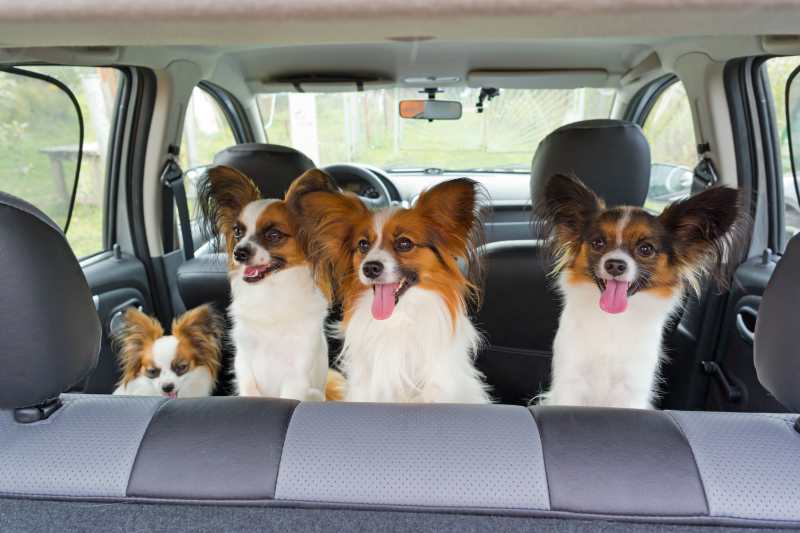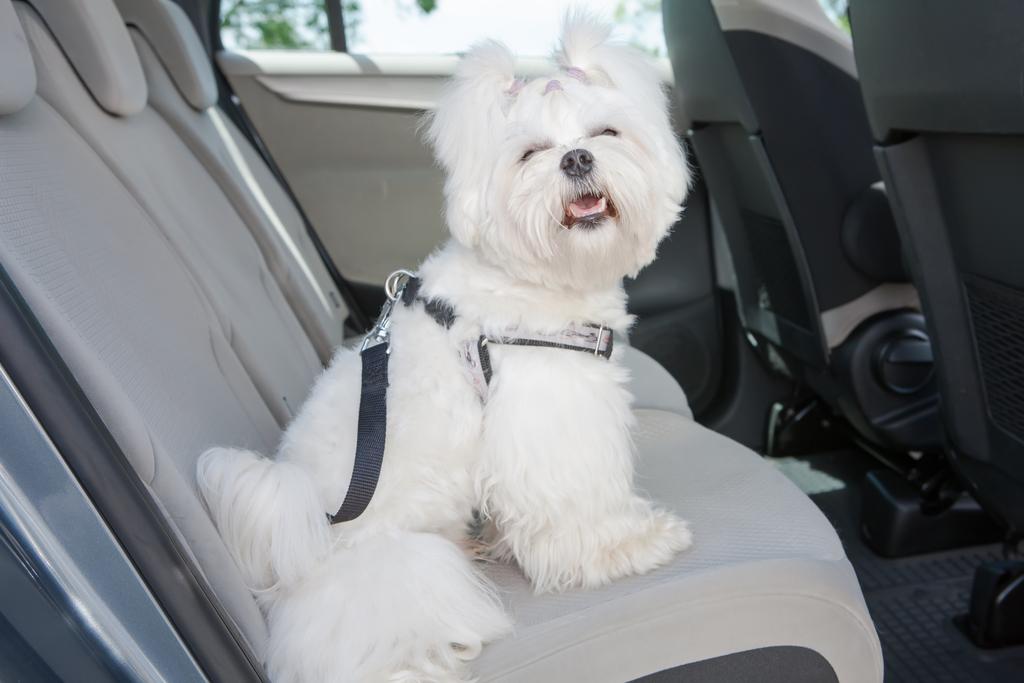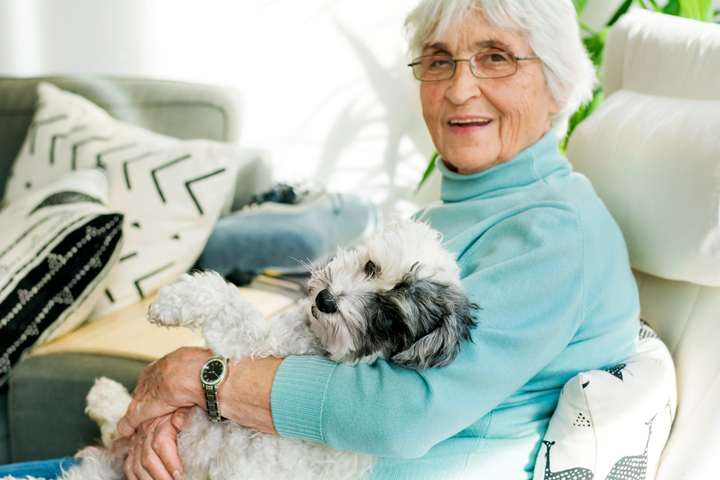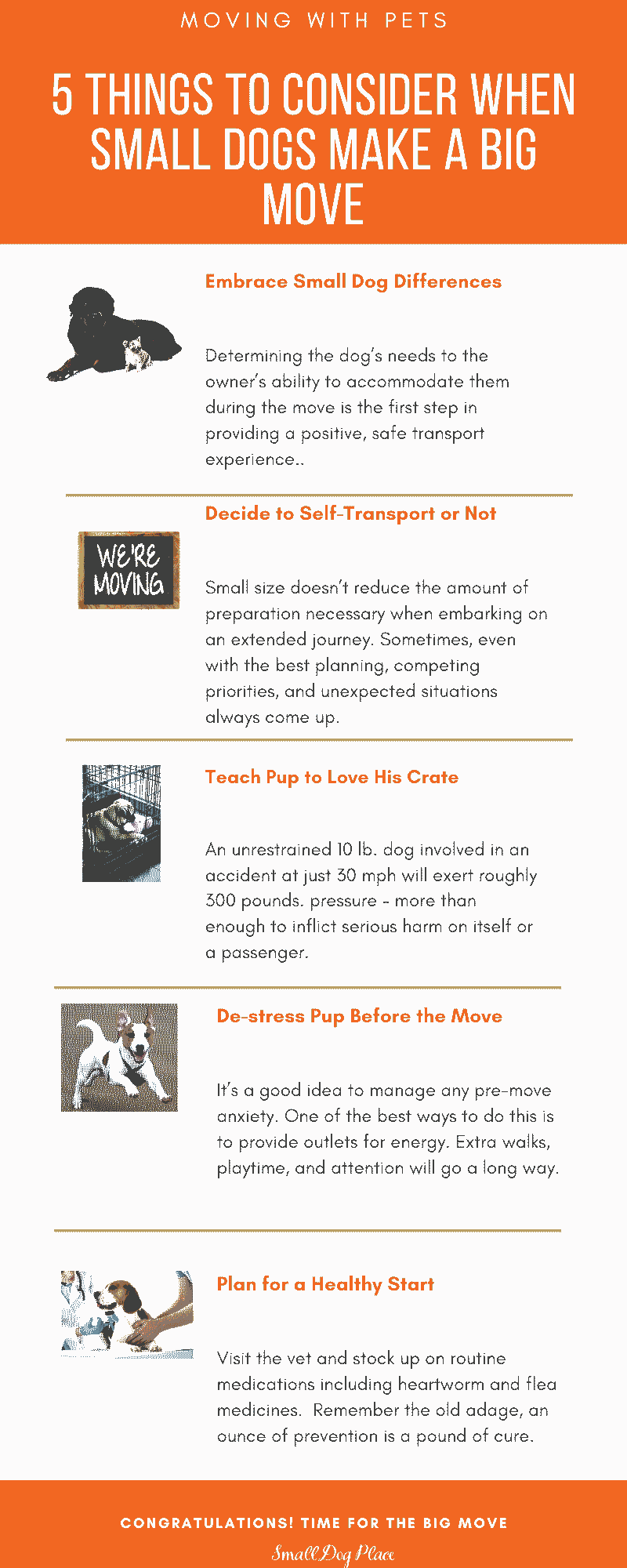- Small Dog Place Home
- Lifestyle
- Moving with Pets
Moving with Pets: 5 Things to Consider When Small Dogs Make a Big Move
Moving with Pets by Julie Bina |Updated 04-08-2024
Americans and their canine companions are on the move. In fact, the average American moves more than 11 times in his or her lifetime1. And for more than 60% of American homes, this relocation includes a precious pup2 – of which more than half are small breeds (under 25 lbs.)3.
 Moving with Pets can be stressful, but with some pre-planning, the move can be done successfully in a more tranquil manner.
Moving with Pets can be stressful, but with some pre-planning, the move can be done successfully in a more tranquil manner.Moving across town, across state, or across the country is never easy. Considered one of life’s top stressors, pulling up stakes impacts every member of the family, including small, four-legged fur babies.
The act of relocation has a lot of moving parts (no pun intended), so it’s easy to see why it can become overwhelming, generating enormous amounts of anxiety.
One way to get a handle on the huge task at hand is by breaking parts of the process down into smaller actions or decisions. There’s nothing more satisfying or stress-reducing than checking off an item on a “to-do” list.
Deciding in advance how a beloved dog gets “home” solves not only a logistical dilemma but delivers peace of mind before, during, and after the move.
Moving With Pets: 5 Tips To Make Relocation Easier on Your Dog
1. Embracing Small Dog Differences
 Moving with Pets: Consider the Special Characteristics of Small Dogs
Moving with Pets: Consider the Special Characteristics of Small DogsWhen considering moving options, it’s important to remember that not all dogs are created equal. Certainly, there are common-sense rules that apply across the board when transporting human’s best friends such as ample food, water, and bathroom breaks.
However, there are real differences to consider and accommodate when the fur baby involved is a small dog.
The stereotypical temperament differences that exist between small dogs and larger breeds are hardly a secret. Hard to train. More fearful. More aggressive. Less friendly.
While many small dog lovers may rightfully disagree, there is research that seems to support some of these common beliefs.4
Interestingly, the research shows it is owner behavior that drives the existence of these traits, not the size of the dog. But, that’s a discussion and topic for another day.
The takeaway here is that when deciding how to transport a small dog, be honest about the personality of the pup and acknowledge where some challenges may exist. No one knows or loves a small dog like it’s human Mom or Dad.
Determining the dog’s needs to the owner’s ability to accommodate them during the move is the first step in providing a positive, safe transport experience.
2. To Self-Transport or Not?
 Consider Whether to Self-transport or Not when Moving with Pets
Consider Whether to Self-transport or Not when Moving with PetsAt first, the solution for moving with a small dog seems not only obvious, but simple. And in some cases, like a quick relocation across town or to a nearby neighborhood, it is. Riding shotgun in an owner’s car (safely in a secured carrier) is often the perfect answer for short trips.
However, longer distances coupled with complicating circumstances require considerably more planning when a pup is along for the ride. Often this fact is overlooked or dismissed, especially when a small dog is involved.
Sure, it’s easy for a pint-size pup to jump in the car and go. But, this isn’t a trip to the grocery store or dog park. Small size doesn’t reduce the amount of preparation necessary when embarking on an extended journey.
Sometimes, even with the best planning, competing priorities, and unexpected situations – like sick children, limited space, traffic issues, weather delays, or mechanical breakdowns - may compromise the ability of an owner to put the dog’s needs first. So plan for the best and consider contingencies if something unexpected occurs.
A pet owner looking to avoid this situation and ensure pup priority throughout the moving process may want to consider a reputable pet transport service.
There are a couple of things to keep in mind when searching these sources online. First, it’s important the service specializes in pets and has transporters who focus on the needs of small dogs and are USDA certified.
It’s also critical that the owner can customize a small dog’s experience based on its temperament and preferences. Look for transporters who understand that just because the pup is out of sight doesn’t mean it’s out of the owner’s mind.
Work with a source that enthusiastically embraces ongoing communication to provide peace of mind throughout the journey via emails, phone calls, texts, and yes, even video dog chats.
3. Teach Your Pup to Love His Crate

Nothing conjures up “warm fuzzies” like a small furball cuddled up on a lap during a long journey. The reality is it only takes a second for something to go very wrong with that picture.
An unrestrained 10 lb. dog involved in an accident at just 30 mph will exert roughly 300 pounds. pressure – more than enough to inflict serious harm on itself or a passenger.5
Crating also limits the possibility of a small dog bounding from a car during a pit stop and getting lost or injured. In short, crating is caring.
So, what makes a good crate? It’s all about size and weight. In general, the crate needs to be large enough for the dog to stand up or sit down comfortably and has a door that can be easily climbed through.
If a pillow or padding is added, it may make sense to go a bit larger. Check the “up to” weight of the crate to ensure the pup it will protect is under the stated poundage range.
For owners using a transport service, the crate discussion is a key one. All top small dog transporters utilize crates of varying sizes, and the rental of one is usually included in the delivery fee. To be safe, always confirm this with the transporter before pick-up.
Flying presents different requirements and containment challenges. Most airlines are very specific about the type of carrier allowed in the cabin. This information can usually be found on airline websites.
Also remember, the dog has to come out of the carrier for security, so a leash is recommended as part of any air carrier ensemble.
4. De-Stress the Pup – Before the Move
 When Moving with Pets, always try to de-stress your dog before the move.
When Moving with Pets, always try to de-stress your dog before the move.A recent study6 suggests what most dog lovers have always known – pups pick up on the anxiety of their humans - and it stresses them out!
Pet owners, especially those with small dogs more prone to excitability and anxiousness, may notice stress-related behaviors long before all the boxes are packed, and the moving crate is opened.
It’s a good idea to manage any pre-move anxiety, so the dog is as relaxed as possible for the actual moving experience. One of the best ways to do this is to provide outlets for all that nervous energy. Extra walks, extra playtime, extra attention will go a long way to assuring a furry family member that everything is okay.
Another tactic is to begin familiarizing the dog with items that will be used during the actual transport. Set the carrier or crate out and let the pooch walk in and out of it.
Put favorite toys and treats around transport items such as food, blankets, and bowls. Make it part of pup’s everyday life. Also consider buying a thunder vest for the actual trip and try it out a few times before the journey.
If a transport service is involved, arrange for the driver to come a little early so the dog and he/she can bond a bit before taking off. This will also allow for any last-minute instructions and provide the owner with an assurance that their baby is in good hands.
5. Plan A Healthy Start with a Vet Appointment
Last, but certainly not least, pay the vet a visit for an overall check-up before making a move. The last thing a pet owner wants is for some unknown health issue to develop during the trip.
For owners using a transport service, many actually require a vet report to confirm fitness to travel and verification that all shots are up-to-date.
This also is the ideal opportunity to discuss and obtain medication options to provide extra comfort and stress-relief if the pet owner thinks they are necessary.
Never give a dog, especially a small one, any medication other than those prescribed by a vet and always pay close attention to dosage.
 Moving With Pets Infographic. Please Pin for Future Reference
Moving With Pets Infographic. Please Pin for Future ReferenceReferences
1https://fivethirtyeight.com/features/how-many-times-the-average-person-moves/
2https://www.iii.org/fact-statistic/facts-statistics-pet-statistics
3https://www.petfoodindustry.com/articles/4903-ownership-of-small-dogs-on-the-rise
4https://www.psychologytoday.com/us/blog/canine-corner/201507/behavior-differences-between-smaller-and-larger-dogs
5https://www.cnn.com/2012/03/16/living/pet-car-ride-dangers/
6https://www.huffpost.com/entry/dogs-stress-humans-study_l_5cf972dee4b0b08cf7eb281d
Author Bio
Julie Bina is a writer for CitizenShipper, an online community that brings pet owners together with pet transporters. She is part of a team of passionate pet owners committed to improving and enhancing the lives of furry family members.
About Janice (author and voice behind this site)
Having lived with dogs and cats most of her life, Janice served as a veterinary technician for ten years in Maryland and twelve years as a Shih Tzu dog breeder in Ohio.
Her education includes undergraduate degrees in Psychology with a minor in biology, Early Childhood Education, and Nursing, and a master's in Mental Health Counseling.
She is a lifelong learner, a dog lover, and passionate about the welfare of animals. Her favorite breed for over 50 years has been the Shih Tzu, but she has also lived with Poodles, Maltese, Yorkshire Terriers, Beagles, English Bulldogs, Carin Terriers, and a Cocker Spaniel.
When not writing, reading, and researching dog-related topics, she likes to spend time with her eight Shih Tzu dogs, husband, and family, as well as knitting and crocheting. She is also the voice behind Miracle Shih Tzu and Smart-Knit-Crocheting
Does This Article Deserve Your Thumbs Up?
We always appreciate your support and encouragement. Your thumbs up means so much to us. Please like this article.
If you find this page or any page on Small Dog Place Helpful, or useful in anyway, I'd love it if you would click the small heart found on the bottom right of each page.
You can also share or bookmark this page -- just click on the:

Free Monthly Newsletter
Sign Up for Our Free Newsletter and get our Free Gift to You.
my E-book, The Top 10 Mistakes People Make When Choosing a Dog (and how to avoid them)






